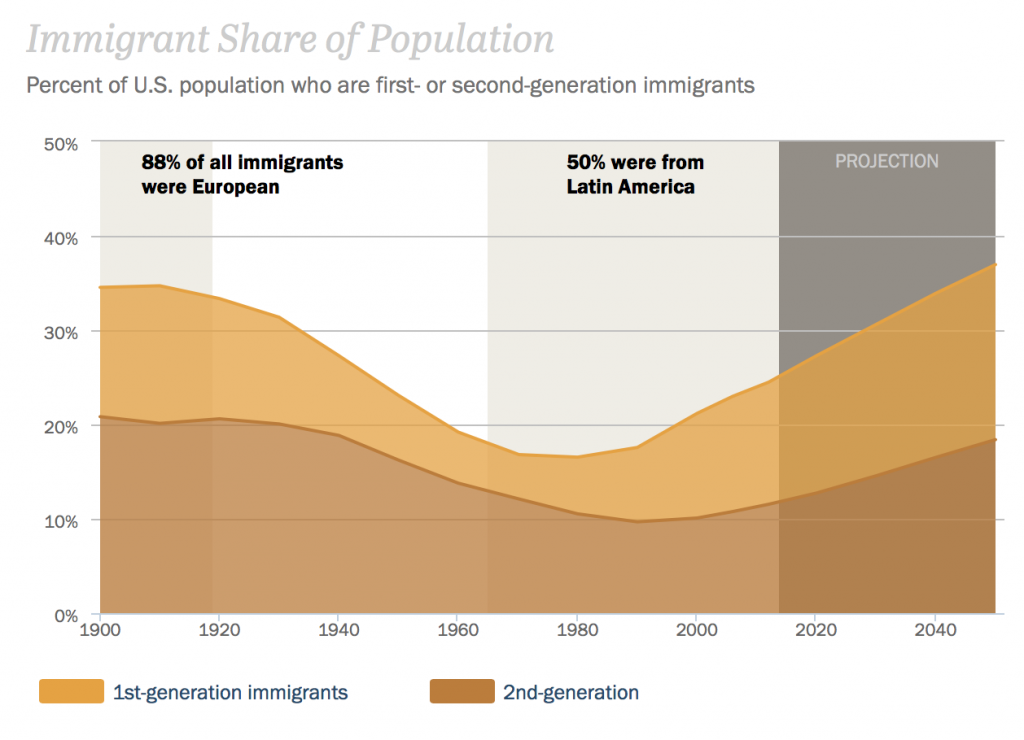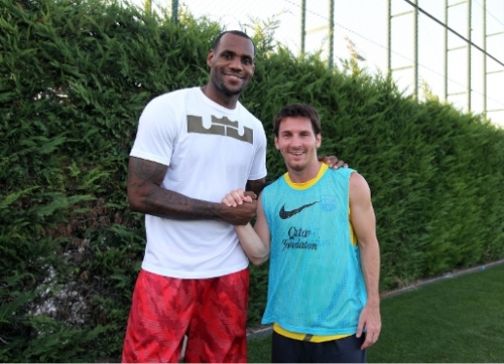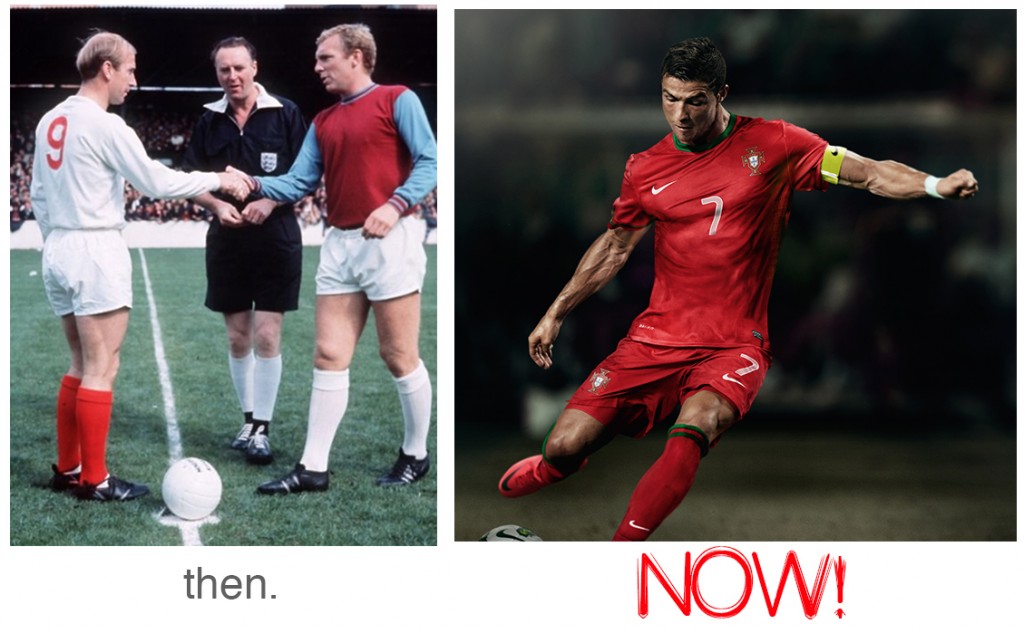 Since the U.S. is fully engaged with this year’s World Cup, I figured this was the perfect time to share my thoughts on why I believe soccer is at the cusp of mainstream popularity in American culture.
Since the U.S. is fully engaged with this year’s World Cup, I figured this was the perfect time to share my thoughts on why I believe soccer is at the cusp of mainstream popularity in American culture.
I know, I know. Soccer has been talked about for years in terms of gaining popularity, especially during these high profile worldwide tournaments. But, I believe there is something different underway.
Here are 8 reasons why soccer will be big in the U.S. and 1 that may hold it back.
1. Changing Demographic of the U.S.
The ethnic make-up of the U.S. is changing by the day…by the minute.
In a recent Pew Research study it was projected that the U.S. population would rise to 438 million by 2050. 82% of that growth would be attributed to immigrants arriving in the country and their descendants.

With this massive population shift comes an innate love for the game. A large portion of this population will bring their love for soccer to the U.S. and will inject a new level of passion for the sport.
2. The Viewing Experience
Let’s face it, watching U.S. sports takes a long time. Even NFL and NBA games push 3 hours these days. With the number of timeouts and commercials, games tend to drag on and become disjointed.
With soccer, this all changes. You basically sit down and watch 45 straight minutes of the game without interruptions. You take a quick break for halftime and then finish out another 45 minutes of uninterrupted action.
Total time is just about 2 hours. Don’t even get me started with baseball. Those games can push 4 hours!
We live in a society today where our attention span is short and our ability to commit time is limited. Having the ability to watch a game without breaks and finish it in the amount of time it takes to watch a movie is a huge bonus for soccer.
3. Better Uniforms
This may seem ridiculous at first, but hear me out. Think back to the mid-80s when you watched the NBA. Then remember when Michael Jordan burst onto the scene and brought fashion to the sport – the long shorts, the designer high tops. Even Jordan’s physical appearance was something to behold. I always said that if Jordan was ugly, he might not have been as big as he was.
We can’t ignore the marketing side of it.
Now look at the evolution of the soccer jersey, or kit as they call it throughout the world. What used to be gaudy, tacky, and ill-fitting has now morphed into super sleek designer uniforms that accentuate the incredibly fit physiques of today’s players.
There’s no doubt marketing and the “look” of the sport are huge aspects to the popularity of any sport. Soccer is no different. It’s now cool to wear soccer jerseys since they are so bad-ass.
4. Concussions in the NFL
Football is the most popular sport in the U.S. and won’t lose that crown anytime soon. But, the NFL also has an issue with concussions. They are a medical reality and people are really paying attention to the dangers of playing the game.
One major group paying attention is parents. Moms and dads are now starting to think twice about having junior throw on the helmet and shoulder pads.
Soccer has traditionally been a popular sport among the youth but at some point those athletes would move to the mainstream U.S. sports of baseball, basketball, and football.
Given the awareness surrounding the risks of football, more of those kids may stick with soccer going forward. In a recent study by ESPN, soccer had actually matched the popularity of major league baseball for the first time in 20 years amongst kids 12-17.
Sure there are risks in soccer too, but they pale in comparison to the brutal hits seen in football.
5. Better Athletes
With the number of kids sticking with the sport, the growing popularity, and the risks of football, there’s no doubt the American soccer player is evolving into a more dominant athlete.
The prevalent American thought of the past was that soccer was reserved for those that couldn’t “cut it” in the major sports of baseball, football, and basketball. This notion has changed and the athletes playing the game today are some of the best athletes in the world.
Taking a look at one of the greatest players in the world, Lionel Messi, it’s apparent that being a physical freak is not necessary. He looks like an accountant for goodness sakes.
 I wonder what would happen if you took a lifetime growing up playing the game and merged it with a body like LeBron James. I’m not sure that would be good or not, but imagining a team of LeBrons playing like Messi is simply enticing.
I wonder what would happen if you took a lifetime growing up playing the game and merged it with a body like LeBron James. I’m not sure that would be good or not, but imagining a team of LeBrons playing like Messi is simply enticing.
6. Ability to Watch Games From Across the Globe
The cable, satellite, and online industries have grown by leaps and bounds. We now have access to sports from around the world at the touch of a button. We now have the ability to sit down on the weekend and watch all the major games from some of the greatest international leagues.
It used to be extremely difficult to find a soccer game on TV, especially one that was any good. Now you can easily watch the world’s best players on a weekly basis. This access is sure to contribute to the growth of the sport in the U.S..
7. The Internet Generation
We live in a brave new world. The concept of borders has greatly been reduced. Interaction and engagement with people from around the world is now commonplace. Social media, online video services, and other capabilities have made it easier than ever to communicate with someone on the other side of the globe.
This new way of thinking makes soccer something we can more easily relate to. It’s no longer a foreign sport played in some country that we regard as far away and unknown.
8. Realization That Low Scores are OK
Ok, some people will immediately counter an argument for soccer with something like this, “they don’t score enough in soccer.” To me, this is a stupid argument.
Two of the major sports in the U.S., baseball and hockey, often conclude with a low score. How many baseball games have you watched that end 1-0? And, as noted earlier, that’s after 4 hours of playing the game!
Yes, soccer has low scoring games, but they can be incredibly thrilling. The U.S. will come to love the dynamic and fluid movement of the game and start to enjoy the buildup for that single goal. It truly is a beautiful game once you understand the concepts and appreciate the strategy.
What Might Hold it Back…
So, with all the good news and reasons for growth of the sport in the U.S., how could it possibly fail?
I’m not sure this would cause a failure, but it may slow the popularity of the game. I’m talking about expansion within Major League Soccer (MLS).
The homegrown league has experienced quite a bit of growth and increased popularity in the U.S., but the league needs to be careful. There are currently 19 teams and 2 new teams starting in 2015 (New York FC and Orlando City). The league hopes to expand to 24 teams by 2020.
There are some that would say the league is already over-saturated and the level of play dips with the lack of quality players throughout the league. This is not the Premier League where world class talent rides the bench.
Too much expansion can be a bad thing. Look at the NBA. There are too many teams in the NBA and as a result some of the teams will never be a legitimate title contender.
It’s a delicate balance in maintaining competitive quality games while not diluting the product. I worry that MLS will add too many franchises and will ultimately bring down the quality of the game on the homefront.
What Do YOU Think?
Do you think soccer has finally arrived in the U.S. and will be a force in the future? Is there a reason that I left off the list?
I’d love to hear your thoughts.

I think soccer has a way to go. It is easy to rally behind the national team, but when World Cup is over, it could be business as usual.
For soccer to take off here, MLS has to be successful. I think television is critical. The NFL existed for years, but did not really take off until the 1960s with television. Before that people regarded NFL players as old men playing a kids game. Besides ESPN, MLS should have at least one game a week on the regular networks. Advertising is the key and capitalizing on MLS players who appeared in World Cup such as Dempsey, Zusi, Bradley, Cahill (Australia) and others.
MLS needs to use the next few weeks and couple of months to take advantage of momentum of World Cup.
Also, more TV coverage of the USMNT (and USWNT) would help in the other tournaments. In 2015, USMNT will be participating in the Gold Cup. Very few Americans are aware of that. Also, when the USMNT is in a town like Tampa or Miami, billboards, radio advertising and newspaper ads should go up so people can fill the stadiums. USMNT competes every year, but most of us only know about the WC.
I apologize for rambling. Bottom line, TV exposure and filling stadiums are what is needed to take soccer to the next level here in the US.
Great article, by the way.
Thanks Rich! Great comments and I completely agree. I really like how MLS is starting to embrace stadiums BUILT FOR soccer. Enough of MLS teams trying to use NFL stadiums…makes the sport look unpopular with all the empty seats. If they continue to invest in stadiums built for the game and feature it on TV, then you have something. I love the Portland Timbers fans…crazy!
I’m a sports nut and can’t stand soccer. There are a lot of us. We’re the demographic soccer needs to win but can’t because we’re to stubborn to win over 😉
I actually agree with Doc Kennedy above, there are so many non-soccer fans that are adamantly not soccer and there’s almost no way to convince them to join the soccer lovers like myself. With the MLS still several generations away from any chance of being a top tier league, theres really only one way I can see of turning the non-believers. That hope lies in the success of the national team.
Luckily for us, with our soccer culture centering around youth development now a days (see the $65 million soccer center being built in Kansas City) we can reasonably hope that more young players will turn to soccer as opposed to the other mainstream sports. As more young talent turns to soccer, our talent pool increases and the team starts to preform better. That is where we can start to gain a larger pool of followers, and failure to do so will leave soccer to plateau off at the level of popularity it has already reached.
A co-contributor to the site I write actually did an in-depth article on th subject if anyone has a desire to read more http://soccernstuff.blogspot.com/2014/07/the-usa-future-powerhouse.html
Amen Patrick. So true that the fate of popularity lies mostly with the national teams. Even though I consider myself a soccer fan, I rarely watch MLS games. Perhaps it’s the TV contracts they have and not being able to easily see them. BUT, I will wake up early on weekends to watch Liverpool. lol